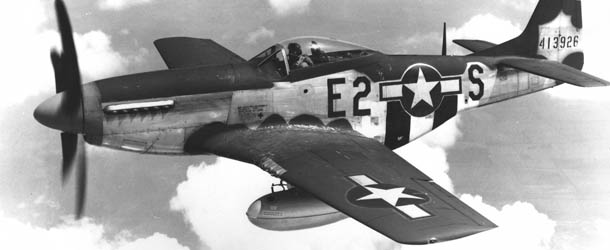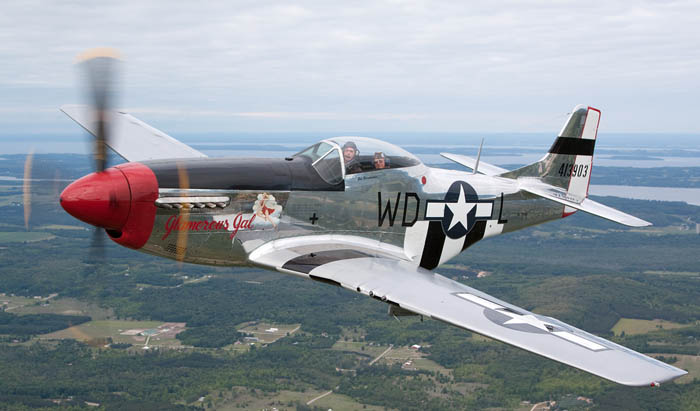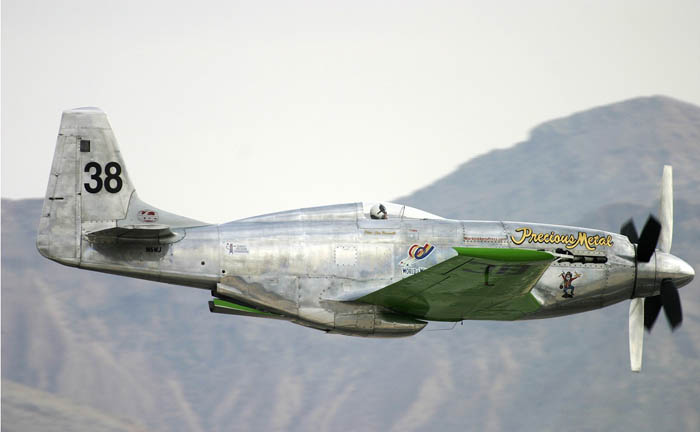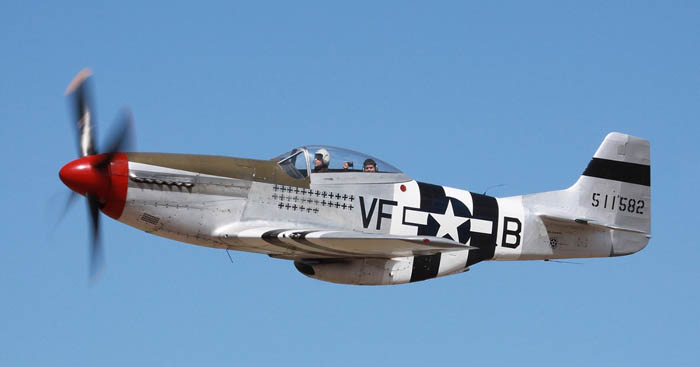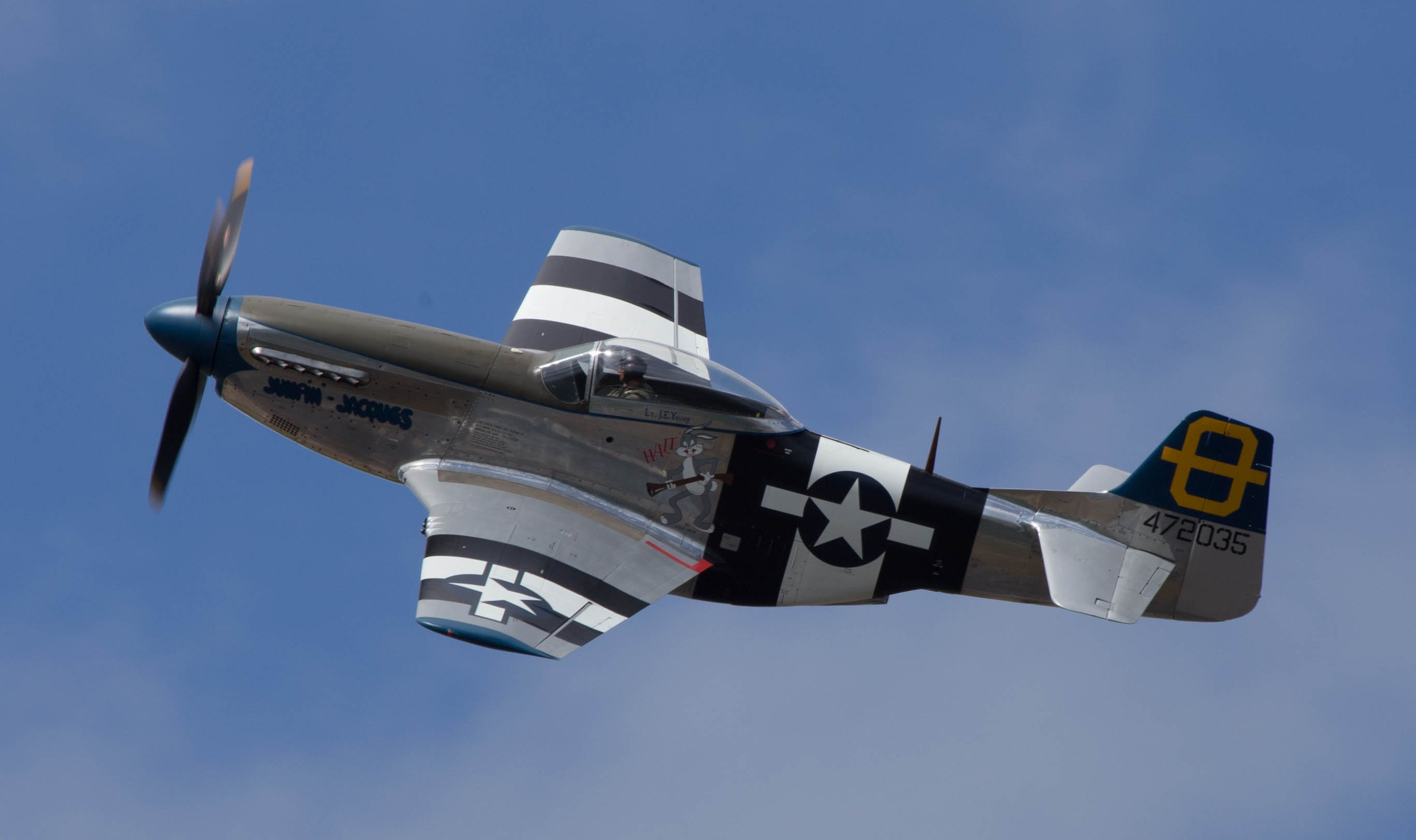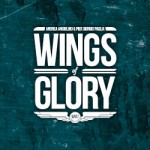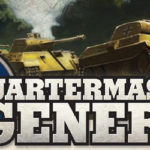The North American Aviation P-51 Mustang was an American long-range, single-seat fighter and fighter-bomber used during World War II, the Korean War, and other conflicts.
The Mustang was conceived, designed, and built by North American Aviation in response to a specification issued directly to NAA by the British Purchasing Commission. The prototype NA-73X airframe rolled out on 9 September 1940, 102 days after the contract was signed and, with an engine installed, first flew on 26 October.
The Mustang was originally designed to use the Allison V-1710 engine, which had limited high-altitude performance. It was first flown operationally by the Royal Air Force (RAF) as a tactical-reconnaissance aircraft and fighter-bomber (Mustang Mk I). The addition of the Rolls-Royce Merlin to the P-51B/C model transformed the Mustang's performance at altitudes above 15,000 ft, giving it a performance that matched or bettered the majority of the Luftwaffe's fighters at altitude.
The definitive version, the P-51D, was powered by the Packard V-1650-7, a license-built version of the Rolls-Royce Merlin 60 series two-stage two-speed supercharged engine, and armed with six .50 caliber (12.7 mm) M2 Browning machine guns.
From late 1943, P-51Bs (supplemented by P-51Ds from mid-1944) were used by the USAAF's Eighth Air Force to escort bombers in raids over Germany, while the RAF's 2 TAF and the USAAF's Ninth Air Force used the Merlin-powered Mustangs as fighter-bombers, roles in which the Mustang helped ensure Allied air superiority in 1944.
The P-51 also serviced with Allied air forces in the North African, Mediterranean, and Italian theatres, and saw limited service against the Japanese in the Pacific War. During World War II, Mustang pilots claimed 4,950 German aircraft shot down, the most of any Allied fighter.
The D model, by far the most numerous P-51 (over 8.000 produced) and also the best known, began development in 1943. It improved on two drawbacks of the B/C model: poor rearward visibility and inadequate firepower of four machine guns (which were mounted at an angle and were subject to frequent jams).
Even the Malcolm hood hadn't fixed the P-51's rearward visibility problem. Learning from the British installation of a "bubble" or "tear-drop" canopy in the Spitfire, both Republic (for its P-47) and North American Aviation (for the P-51) started work on a Plexiglass bubble canopy in mid-1943. For stability, and to prevent distortion, the canopy was mounted in a very deep, rubber-lined metal sill; it slid back on rails. To accommodate the canopy, the rear fuselage was cut down. The new version included six .50 caliber machine guns, mounted upright, minimizing jams.
Test pilot Bob Chilton first flew the XP51-D in November, 1943. The Inglewood plant eventually turned out 6500 -D models; the Dallas plant produced 1600 of the identical -K model.
The 85 gallon fuselage tank was included on the P51-D from the start. The directional stability problems that it caused for the B/C models worsened in the first D models. To correct this, a dorsal fin was added, starting with Block 10 of the P-51D.
Another new feature of the P-51D was the K-14 gunsight, which greatly assisted deflection shooting. The K-14 computed and displayed the correct angle of deflection needed to hit a moving airplane. The pilot entered the wingspan of the target and the range, lined up the target and pressed the trigger button.
It was the European Theatre, flying over Germany, that made the Mustang and many of its pilots famous. The Eighth Air Force had struggled with its daylight bombing missions over Germany; unescorted, the bomber losses were unsustainable. With the Merlin engine, the Mustang could fly over eight hours and have time to dogfight the Luftwaffe as well.
The 354th Fighter Group, temporarily assigned to the Eighth AF, was the first group to fly Mustangs over Europe. Other groups followed. The 357th flew its first Mustang combat missions in February, 1944. Shortly thereafter, the 4th Fighter Group received their P-51B's (just in time for "Big Week," the USAAF late-February assault on Germany). "Big Week" was a direct attack on Germany's fighter force: bombing its manufacturing plants and airfields, and shooting its operational planes out of the sky.
In early 1944, VIII Fighter Command (VIII FC) focused on destroying the Luftwaffe. It encouraged and publicized aces; destruction of planes on the ground "counted" in a pilot's tally. This was an unusual step; no other air force has ever recognized "ground kills" in a fighter pilot's claims, but VIII FC figured that "a plane was a plane" and strafing was hazardous and unpopular. So, it offered the recognition. Decoration of personal aircraft with kill-markers, little swastikas or crosses near the canopy rail, was permitted or even encouraged, as was decoration of planes with group color schemes. Thus, the 352nd were the "Blue-Nosed Bastards of Bodney."
While best known for its service in Europe, some Mustang units saw service in the Pacific and the Far East.
Information sources: Ace Pilots, Military Factory, Wikipedia, Airliners.net, Planephotos.net, Deviantart.com

